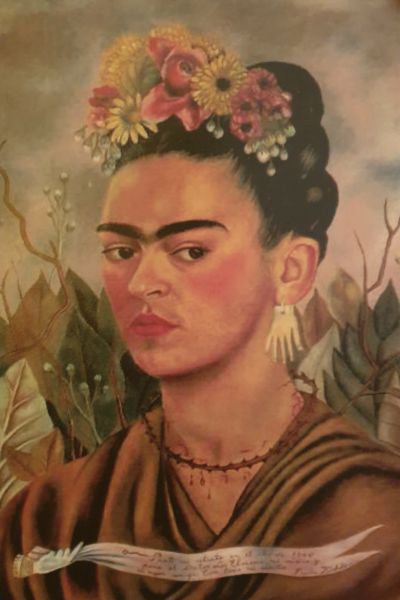The Frida Khalo Effect
Frida Kahlo – named Magdalena Carmen Frida Kahlo y Calderón – took up painting in 1925 after a near fatal bus accident. She was only 17 when an electric streetcar, also known as a trolley, rammed the bus she was travelling in.
Khalo was left with severe damage to her spine, pelvis, collarbone, right leg and foot and ribs. For decades she submitted to brutal surgical procedures which failed to repair her damaged spine.
The second accident she mentions was her passionate and turbulent relationship with the famous Mexican painter Diego Rivera. He was a political muralist and initially better known than Kahlo.
She met Rivera at the age of 14 and promptly developed a crush on him. However, she didn’t become his lover until years later. Their political allegiance was primarily to Communism and they were united in their passionate love of Mexico.
They married in 1929 in Coyoacan, Mexico, divorced and then got married again. They both took other lovers and Khalo had affairs with both men and women.
Rivera distinguished himself and caused Kahlo great anguish by having an affair with her sister. Despite being a notorious womanizer Rivera was prone to jealousy and outbursts over Kahlo’s lovers.
Rivera was 21 years older than Kahlo. Whereas he was tall, robust and heavy set, Kahlo was petite, chic and elegant. Her mother alluded to them as a mismatched pair, describing them as ‘an elephant and a dove.’ Kahlo’s father, a German photographer, was more impressed with Diego than his wife.
Kahlo dressed in folk costumes and chunky Mexican jewellery. In her paintings she frequently overemphasized her monobrow and dark moustache. She was heavily influenced by Mexican folk art but developed her unique naïve style.
When Rivera became internationally acclaimed, they went to America so he could produce commissioned murals. Their residency in America bought Kahlo and her unique paintings to the attention of the international art world.
Kahlo was frequently bedridden and unable to leave the house. Her main subject became herself – simply because other subjects were not available to her.
The Surrealists tried to claim her as their own – Andre Breton assumed the animals in her portraits were dream-like but Kahlo insisted she dealt only with reality. She was painting her domestic surroundings and her home was full of animals including monkeys and Mexican hairless dogs.
When she died at 47, she left a body of fifty paintings which were primarily self-portraits. Khalo constantly portrayed herself as she sought to define herself and her identity. She chose to paint her ongoing struggles to master her physical pain and make sense of her passionate but difficult relationship with Rivera.
The Gelman Collection of Frida Khalo’s paintings have arrived for exhibition in Adelaide. The exhibition is titled – Frida and Diego: Love and Revolution.
The Gelman Collection is so popular it tours the world continually – but it will be ‘rested’ after its visit to South Australia.
In a recent interview, the curator of international art at the Art Gallery of SA spoke about the allure of Khalo’s work. Tansy Curtin believes Kahlo fascinates because she’s in direct communication with the viewer.
‘By laying herself bare, we the audience are essentially laying ourselves bare. We see ourselves in a way that we perhaps don’t show to people around us…’
by Lesley Truffle
image: Self Portrait, Dedicated to Dr Eloesser by Frida Kahlo 1940.
